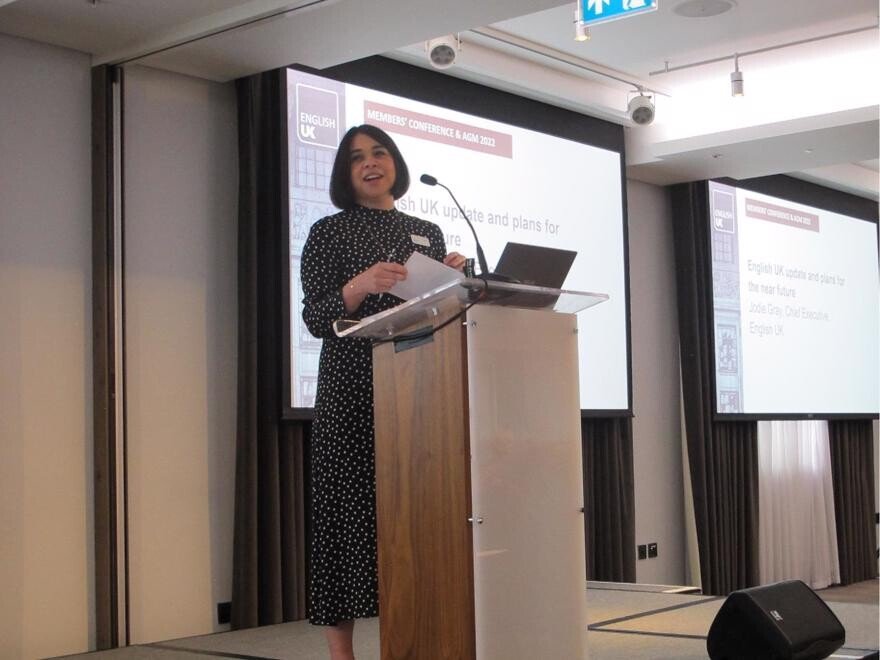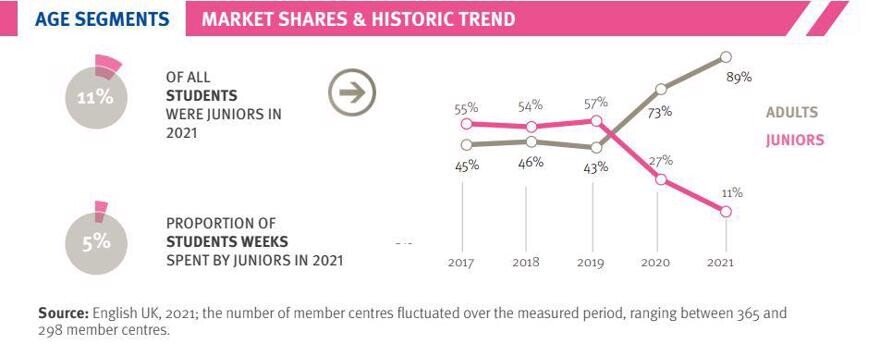Overall data: The English UK Student Statistics Report 2022 shows that 53,616 students were welcomed in 2021, representing a 35.7 per cent decrease compared with 2020 and only around a tenth of the 508,614 students hosted in the pre-pandemic year of 2019.
Student weeks, meanwhile, declined by a further 12.9 per cent to 462,046 in 2021, representing less than a quarter of the 1,839,655 weeks delivered in 2019.
For the 325 centres that reported data both in 2019 and 2021, there was an 88 per cent drop in student numbers and a 71 per cent decrease in student weeks between those two years, the authors said.
 English UK Chief Executive Jodie Gray speaking at the 2022 Annual Conference in London last week.
English UK Chief Executive Jodie Gray speaking at the 2022 Annual Conference in London last week.
“It’s sobering to see the concrete proof of what UK ELT has faced during the past two years, though it is much as we all suspected. The incredible thing is that most of our members have survived, and continue to do so despite the additional challenges brought by the end of freedom of movement,” said English UK Chief Executive Jodie Gray .
The impact of the Covid-19 on the junior segment is clear in the latest English UK report. In 2019, young learners accounted for 54 per cent of all students; last year the proportion dropped to only nine per cent. Although UK centres could operate during the summer of 2021, quarantine measures severely curtailed short-term travel.
Source markets: China remained the top source country by student numbers with 8,506 students, a nine per cent decrease compared with 2020, followed by Saudi Arabia (5,931 students, -8.5 per cent) and Italy (3,381, -70.6). The top five was completed by France (3,316, -31.3) and Switzerland (2,894, +9.2).
On the measure of student weeks, Saudi Arabia was the top source country with 71,773 weeks, followed by China (69,168), Kuwait (35,299), Japan (25,139) and France (19,779).
The average stay was the highest ever recorded for English UK at 8.6 weeks overall. Among top ten source countries, Romania had the longest average stay at 17.2 weeks, followed by Kuwait (12.3) and Saudi Arabia (12.1).
Regions: By region, Northern England hosted the largest proportion of student weeks in 2021 (26 per cent), followed by London (25) and the South and South Eastern England (17).
State/private sector: The state sector was slightly more resilient in 2021. The 41 state sector members welcomed 13,011 students in 2021, a decline of 5.7 per cent compared with 2020. The top five source markets (by student weeks) were: China (41.2 per cent of student weeks), Romania (12.7), Poland (6.4), Saudi Arabia (5.4) and Spain (2.7).
The 298 private sector members in the report welcomed 40,605 students last year, a 42 per cent decrease compared with the previous year. Average course length increased from 5.4 weeks in 2020 to 7.9 weeks in 2021.
 Source – English UK/Bonard
Source – English UK/Bonard
The top five source markets for private sector members in student weeks were: Saudi Arabia (20 per cent of total student weeks), Kuwait (9.8), Japan (7.5), France (6) and Switzerland (5.5).
Mode of delivery: The English UK report covers only students who booked a face-to-face course, but the association found that only 41 per cent of those students could study fully face-to-face in 2021; 31 per cent undertook a blended programme; 23 per cent ended up studying online from overseas; and six per cent studied online in the UK.
 Source: English Adult/junior trends at private sector schools. Source – English UK/Bonard.
Source: English Adult/junior trends at private sector schools. Source – English UK/Bonard.
Promising signs for 2022: However, presenting the findings of the English UK 2021 data at the association’s Annual Conference last week, Ivana Slobodnikova, Head of International Education at research partner Bonard, gave a preview of more promising trends from the QUIC [Quarterly Intelligence Report] report for 2022 Q1, with a 172 per cent increase in student weeks compared with 2021 Q1 for the participating schools.
The QUIC scheme showed gradual increases in student weeks through each quarter of 2021.
Following recent 2021 reports from Marketing English in Ireland (MEI) and the National Statistics Office (NSO) in Malta, the English UK data completes a downbeat picture of the year for Europe’s ELT sector, with only Malta registering growth and still well below typical numbers. However, all three destinations report more positive signs in the present year.
Commenting on the full-year student statistics report, Jodie said, “As always, the Student Statistics give us both valuable ammunition as we continue our lobbying efforts on behalf of our members, and also valuable information to help and support our members rebuild their businesses post-Covid. We – and they – will be using these figures heavily in the coming months.”




